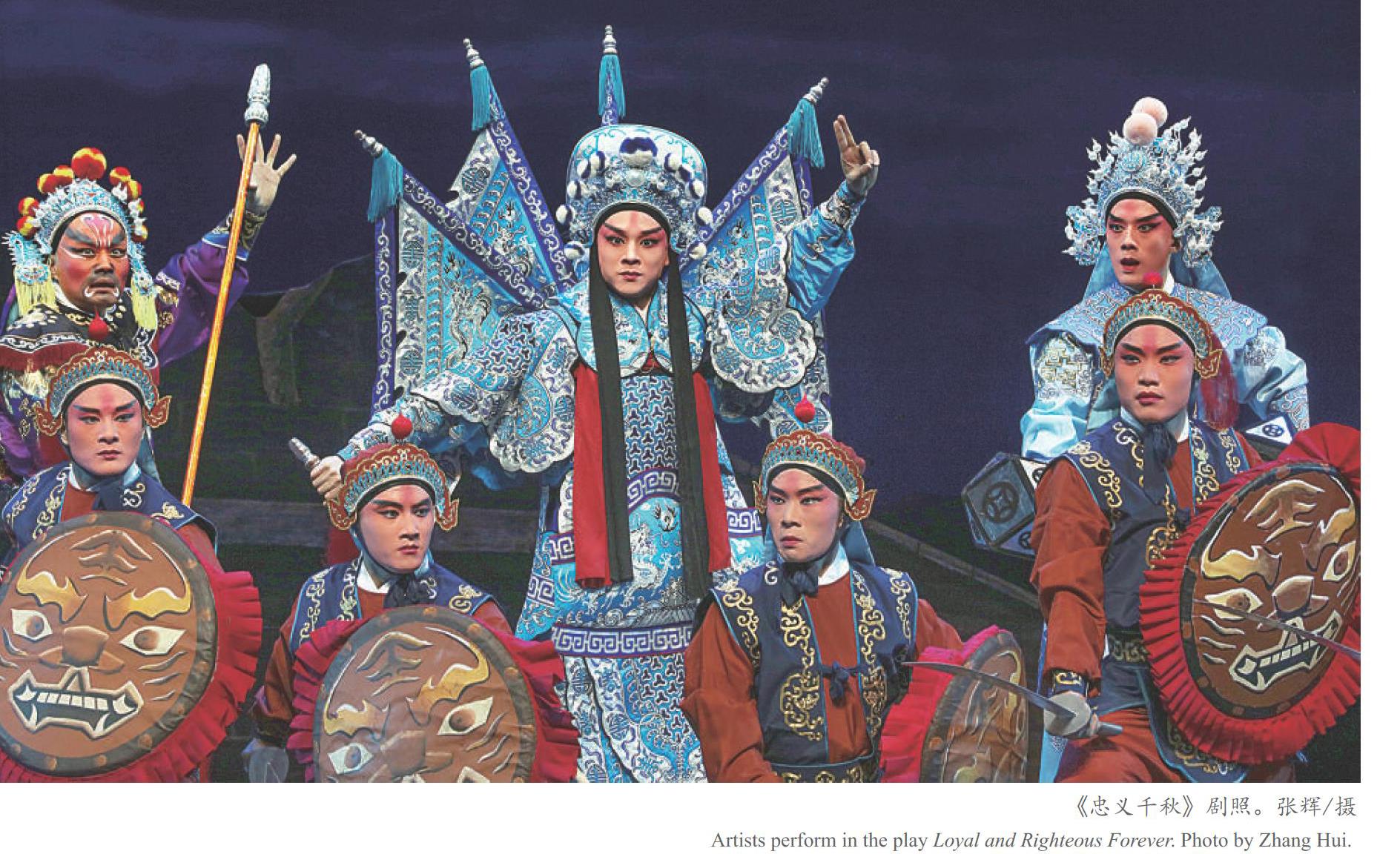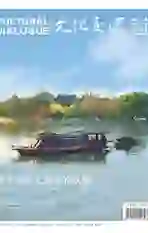婺剧:古韵悠曲绽新蕊
2021-06-24徐露路陆瑶
徐露路 陆瑶



“一条大河波浪宽,风吹稻花香两岸……”一首歌唱响全国,至今脍炙人口。
大河奔流,不舍日夜,而稻花飘香,又从何而来?最新的考古发现证明,稻香的源头已可上溯到一万年前,一条大河的岸边。
它就是位于浙江省中部的金衢盆地,以浦江县上山遗址为代表的上山文化,是世界稻作文化的源头。这片江南丘陵不仅孕育出自给自足的稻作经济,培育出完善成熟的农耕文明,也在精神文化园地里浇灌出芬芳吐艳的繁花,催生了诸如婺学、婺窑、道情等各具形态的奇葩异卉。这其中最朴素、最饱满、最具有旺盛生命力的那一株,当属婺剧。
它是漂流的禾苗
寻找着属于自己的土壤
婺剧是八婺大地的“非物质遗存”,是浙江地方剧种中历史最悠久、声腔最繁多(高腔、昆腔、乱弹、徽戏、滩簧、时调)的艺术瑰宝,在中外戏剧史上占有十分重要的地位。
婺剧的形成,主要的特点就是商路即戏路。金华的地理位置是在江西、福建、安徽、浙江四省交界,同时又是新安江流经钱塘江的重要码头。明清以来,金华一带是盐、丝入赣和漆、瓷入浙的商业贸易地区,加之物产丰饶,故历来是各种戏曲争胜斗奇之地。
明中叶流行的义乌腔形成于金华府(今浙江金华)。明末的高腔、昆腔,清初的乱弹腔,清中叶的徽戏,均流行于金华、丽水、临海、建德、淳安以及江西东北部的玉山、上饶、贵溪、鄱阳、景德镇等地。滩簧清代中叶形成于江浙一带,有常州武进滩簧、杭州滩簧、宁波滩簧、本滩等。时调则是明清以来时尚民间小戏的统称。
以上六种声腔,在婺剧中不是一戏混用,而是各个声腔都有一批专长剧目。最初,高腔、昆腔、乱弹等独立成班,后发展为合班,并有不同的组合。高、昆、乱兼唱的戏班,俗称“三合班”。之后,徽戏传入金华一带,有的三合班弃高腔而兼唱徽戏,有的徽班却兼唱乱弹。再之后,又吸收了滩簧和时调。
于是乎,各种唱腔通过融会贯通,竞争重组,优势互补。婺剧,就这样在农耕文明的沃土上扎根萌芽,汇拢四面八方各具特色的色泽音调,拔节分蘖、扬花吐穗,成长为本土艺术园地里最为丰实饱满的“植物”。
自幼生长在稻田里的婺剧仿佛“赤着脚”,很少有文人雅士愿意掺和进来,历代史书经传里很少能够看到关于婺剧及相关声腔、班社、演员的记载。正因如此,婺剧并不像越剧,有一个非常明确的发源地,各声腔的起源时间各不相同,最早的高腔至今已有500多年历史。
在位于金华市区燕尾洲公园为中国婺剧院底楼的中国婺剧博物馆内,笏板、脸谱、戏服……3000多件与婺剧相关的展品,有的来自老艺人的捐赠,有的是工作人员到各地剧团中收购的,还有一部分是能工巧匠仿制的,从台前到幕后,穿越时空,将婺剧的前世今生娓娓道来。
它像成熟的水稻
丰满的稻穗总是垂向大地
旧社会时,婺剧艺人流离失所,解放初仅在金华地区留下少数班社。解放后,婺剧获得新生。1953年,浙江省文化局以民办公助的形式,成立了金华专区婺剧实验团和浙江婺剧实验剧团,1954年,决定兴办浙江省婺剧团。接着,全区大部分县相继成立婺剧团。
为使婺剧后继有人,浙江婺剧团1955年招收郑兰香、吴光煜等一大批青年演员,1958年,浙江省文化局在杭州创办了浙江戏曲学校婺剧班,该班在全省招演员、乐队45人,是新中国第一代婺剧中专生,毕业分配到全省各婺剧团。
1957年,全省举办一次规模较大的戏曲调演,对演出传统剧目进行推陈出新,逐个进行整理记录,出版了《婺剧传统剧目汇编》、《婺剧音乐:徽戏部分》,使大部分传统剧目和唱腔曲牌得以保存。同时整理和加工出一批优秀传统剧目。
1960年,毛泽东主席在杭州观看了婺剧优秀传统小戏《牡丹对课》后给予热情肯定和鼓励,并接见郑兰香等优秀青年演员。1962年,婺剧首次进京演出,受到首都文艺专家的高度评价。周恩来、朱德、陈毅、彭真等党和国家领导人观看演出后给予热情肯定和鼓励。周恩来总理三次观看演出,并邀请部分演员到中南海住所进行长时间的亲切谈话。著名戏剧家田汉还特地赋诗一首:“璞玉浑金尚可求,英雄儿女入燕幽。浙东何止山川美,又有新声说婺州。”
这一时期的婺剧获得前所未有的绝好发展机遇,经江和义、徐东福、周越先、徐汝英、周越桂、葛素云等前辈老师的悉心培育,以郑兰香、吴光煜为代表的一代婺剧人迅速成长,新老同台,革故鼎新,婺剧艺术迅速提升,赋予婺剧以时代精神,展现地方文化的艺术品格,成为广受城市观众喜闻乐见的剧场艺术。
然而,在熟悉它、养育它的乡亲们眼里,婺剧仍然像成熟的水稻那样,丰满的稻穗总是低低地垂向大地母亲。稻米养育农民的肉体,婺剧充实农民的精神。几百年来,婺剧就这样成为了盆地农民循循善诱的“讲师爷”,朴实地向他们讲述人生的哲理。
浙江婺剧艺术研究院的演出队,会经常来到一些乡镇的文化礼堂进行下乡演出。演出队的花旦演员王丹说,下基层的剧目多会挑一些观众爱看的、能够反映农村生活的戏,比如当天下午的两个现代婺剧《闹元宵》《心愿》,就是反映孝文化的。2011年12月,浙江婺剧团更名为浙江婺剧艺术研究院。如今,他们每年仍坚持公益下乡演出300余场。
婺剧的剧目丰富多彩,据20世纪50年代初统计,能演出的大戏有390个,小戏400余个。既有反映古代历史、政治、战争类题材,也有表现人民丰富多彩的生活类题材。
在表演形式上,婺剧夸张、生动、形象,鲜明生动与激情粗犷相结合。它不但保留了许多傀儡、傩舞、目连戏等古老的表演动作和程式,且拥有变脸、耍珠、耍牙、滚灯、红拳、飞叉、舞叉、窜火、穿刀、十八吊等大量特技表演。
由于过去服装无水袖,婺剧表演多在手指、手腕上下功夫,别具一格。旦角的开门、整装、整容等动作,无不注重手指的颤动功夫。净、生等角色的各种云手动作,也十分注重转腕,翻掌加上亮相时常屈腿亮靴底,与傩舞和佛教舞蹈颇有接近处。角色上场時两肘(下臂)平曲,大拇指翘起,其他四指并拢,起霸时尽用身子旋转动作,扬鞭催马时鞭梢总是向上,又与傀儡戏的动作相似。
它在金衢大地生長
把芬芳撒向五洲四海
2008年,婺剧被列入国家级非物质文化遗产名录。经过历代艺人的发展和传承,当下的婺剧,远不仅局限于在金华地区传唱。
2020年12月4日晚,浙江婺剧艺术研究院走进浙江工业大学,开展“高雅艺术进校园”活动。《闹花台》《八大锤》《金猴闹春》……这些婺剧折子戏中,不仅有传统剧本的经典段落,还有近年来的全新原创现代戏。精彩传神的表演,唱念做打俱佳,赢得现场近千名观众的热烈掌声。
近年来,婺剧的身影在央视春节联欢晚会、春节戏曲晚会等重要舞台上也频频亮相。2019年5月,亚洲文明对话大会“亚洲文化嘉年华”的节目《盛世梨园》中,来自浙江婺剧艺术研究院陈美兰新剧目创作团队的110名演员青春亮相。一排排色彩亮丽的大靠悉数登台,威风凛凛地展示着婺剧功夫。伴随着鼓点的敲打,身穿黄色服饰的十余位武生演员表演长达一分钟的翻跟头接龙,最多的一位演员连翻了6个跟头,让现场观众连连叫好。
如今的婺剧鼓点不仅响彻全国,也在敲击着全球观众的心扉。从1993年开始,浙江婺剧艺术研究院(今)主动承接一系列对外文化交流任务,迄今为止已出访全球近50个国家,将古老优美的东方韵腔唱响世界舞台。近年来,《昆仑女》《梦断婺江》《铁血红颜》、青春版《穆桂英》、《血路芳华》《宫锦袍》《信仰的味道》《基石》等婺剧作品,接二连三摘取中国戏曲舞台上最为耀眼的奖项。陈美兰、张建敏、杨霞云等演员先后获得戏剧梅花奖的荣誉。
繁荣在田间地头的民营剧团,也在为婺剧的传承发展打下更广阔的基石,他们走村入户,送去妙趣横生的演出。去年国庆假期,缙云县碧林婺剧团等演出团体在河阳古民居景区的舞台上开展了婺剧常态化表演,为来往游客展示这一古老戏曲的魅力。团长黄碧林说:“我们团成立于1989年,是从我父亲手里传下来的,算是民营婺剧团里的‘老字号了。目前周边地区比较活跃的民营婺剧团有40家左右,我们计划成立一个联盟,加强民营剧团之间的合作与交流,通过提升演出品质和服务内容进行良性竞争,让民间艺术的魅力惠及更多人。”
在岁月舞台上摸爬滚打好几个世纪,婺剧竟然显得越来越年轻,越来越充满生命活力,就像一株扬花吐穗500年却依然苍翠茁壮的禾苗,在浙江中西部的肥沃土地上茁壮生长,成为婺州文化最杰出的代表和最重要的印记。
The Renaissance of a Traditional Zhejiang Opera
By Xu Lulu Lu Yao
As an intangible cultural heritage, Wuju opera is the oldest local opera in Zhejiang, with six shengqiang or vocal tones, the most varied among any operas, including the high-pitched tune, the Kunqu opera tune, the Luantan (literally “random pluck”) tune, the Huiju opera tune, the Tanhuang (a local folk opera art) tune and the Shidiao (popular local ditties) tune. Popular in the Jinhua area of central Zhejiang province, Wuju opera is one of the most important opera art forms in China.
Contrary to what many may have believed, Wuju opera is not an amalgamation of the six shengqiang or vocal tunes. Rather, each is featured with its own repertoire. Then, there are also different combinations. In fact, in its early years, troupes centered on the high-pitched tune, the Kunqu opera tune or the Luantan tune were formed independently and performed plays based on these tunes respectively. Overtime, those incorporating all three tunes called “tri performance troupes” were born. Later, when Huiju opera was introduced to Jinhua, some tri performance troupes ditched the high pitched tune, and welcomed the Huiju opera tune into their embrace, while a number of Huiju opera troupes instead combined with the Luantan tune. By the time when the Tanhuang tune and the Shidiao tune were assimilated, Wuju opera was even more enriched in terms of both the tunes and repertoire.
It is not a coincidence for Wuju opera to become what it is today. Standing at the intersection of Jiangxi, Fujian, Anhui and Zhejiang provinces, and an important wharf along the Xinan River, Jinhua has historically been a key commercial center in the region. During the Ming (1368 1644) and Qing (1616-1911) dynasties, Jinhua was also a crucial trading post where salt and silk were sold to Jiangxi and lacquer and porcelain were imported into Zhejiang. Coupled with abundant natural resources, there seems no surprise that various people, and indeed operas, were attracted to Jinhua. It is even said that the history of commerce in the Jinhua area is the history of Wuju opera.
Maybe because of the historical mixture and its rural base, Wuju opera was considered uncultured by the literati. It was rarely mentioned in official histories, documents and records, unlike its more refined younger “cousin”, the Yueju opera.
Despite its long history, the development of Wuju opera isnt always smooth sailing, especially in the hundred years or so before 1949, when foreign invasion and wars gripped much of China. At the founding of the Peoples Republic of China, only a handful of Wuju opera troupes were left in Jinhua. In 1953, authorities in Zhejiang established the Jinhua Wuju Opera Experimental Troupe and the Zhejiang Wuju Opera Experimental Troupe, before officially setting up the Zhejiang Provincial Wuju Opera Troupe in 1956, marking the revival of Wuju opera in the new era.
To cultivate more Wuju opera talents, the Zhejiang Provincial Wuju Opera Troupe then recruited quite a number of young performers, including Zheng Lanxiang and Wu Guangyu, who would later grow into masters of the art form. In 1958, 45 students joined a vocational program that was specially tailored for Wuju opera performance, the first cohort after the PRC was established.
Wuju opera received another boost when Chairman Mao watched one of the traditional plays in Hangzhou in 1960, and spoke highly of the performance. Two years later, the Zhejiang Provincial Wuju Opera Troupe had the chance to perform in capital Beijing for the first time. More national leaders, including Premier Zhou Enlai, attended the performance. Premier Zhou enjoyed the show so much that he watched it three times, and even invited some singers to his residence in Zhongnanhai to talk about the opera. Later, with more performances in cities like Beijing and Shanghai, Wuju opera has made more inroads into urban areas.
However, for Wuju opera, its roots ultimately lie in the countryside. Over the past few decades, the Zhejiang Provincial Wuju Opera Troupe has regularly delivered free performances more than 300 every year in recent years-to residents in rural areas. And the plays chosen are usually those either popular with rural residents or adapted to show the latest state of rural life.
The adaption is made all the easy by the rich repertoire of Wuju opera. According to a survey done in the 1950s, there were at least 390 full-length plays and over 400 short plays. The subjects range from history, politics and wars to everyday life. As far as performing is concerned, Wuju opera is characterized by exaggerated and intense movements, with many traditional gestures, footwork and movements. One notable feature is the finger poses and hand gestures, which Wuju opera performers paid special attention to, as the costumes for Wuju opera did not have sleeves in the past. Quite a number of acrobatic moves have also been incorporated , such as face-changing and teeth play.
Today, Wuju opera is a nationally recognized cultural treasure. Apart from public troupes, privately run troupes are thriving as well. In Jinyun county, Lishui city, for instance, some 40 such troupes are planning to form an alliance, to better develop Wuju opera and so that more people can feel its charm. Wuju opera is also stepping onto the international stage. The Zhejiang Provincial Wuju Opera Troupe has so far visited about 50 countries, with more in the pipeline, bringing the art of Wuju opera to a global audience.
